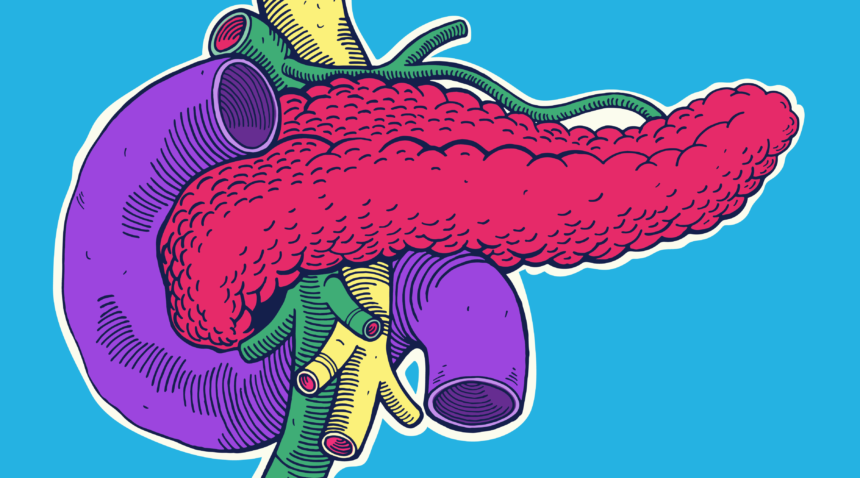One of the basic truths of cancer is that the earlier you find it, the better. Early detection means more effective treatment. And that’s one of the reasons pancreatic cancer is so deadly: It usually isn’t found early.
There’s no screening for pancreatic cancer, and it doesn’t cause many symptoms until it reaches an advanced stage or has spread. As a result, fewer than 1 in 10 people diagnosed with pancreatic cancer live five or more years, making it the fourth-leading cause of cancer-related death in the Unites States.
“The problem with pancreatic cancer and the reason it’s such a deadly disease is that it’s picked up too late,” says UNC Health Care surgical oncologist Michael LeCompte, MD. “Once the cancer spreads, it is difficult to treat. Eighty percent of people present with advanced cancer and are not candidates for surgery, which is the only way to get a cure.”
But experts such as Dr. LeCompte hope that advances in research and treatment will lead to better survival rates in the not-too-distant future.
“There has not been a lot of change over the last four decades in terms of how we treat pancreatic cancer until recently,” Dr. LeCompte says. “We’re improving upon the treatments we already have and introducing some new ones.”
Read on to learn the basics of pancreatic cancer and about new treatments on the horizon.
The Role of the Pancreas
The pancreas is a 6-inch-long gland that produces enzymes to help with digestion and hormones that regulate blood sugar. Cancer can form either in the exocrine cells, which make the enzymes, or the endocrine cells, which make the hormones.
The vast majority of pancreatic cancer cases develop in the exocrine tissue (93 percent), with a minority of cases (7 percent) beginning in the endocrine cells; the latter cases tend to happen to younger people and have a better prognosis.
Signs and Symptoms of Pancreatic Cancer
Pancreatic cancer is often “silent” at the start, with few or no symptoms. As the cancer grows, possible symptoms might include:
- Pain in the abdomen and/or back
- Weight loss or loss of appetite
- Depression
- Bloating
- New diagnosis of diabetes
- Indigestion or nausea
- Diarrhea or constipation
- Blood clots
- Fatigue
- Jaundice
“Pancreatic cancer is usually caught either because it’s causing a blockage in the pancreas or the bile duct, leading to problems with digestion, jaundice or pain,” Dr. LeCompte says.
Risk Factors for Pancreatic Cancer
Nearly 57,000 people are diagnosed with cancer of the pancreas each year, and the average lifetime risk of pancreatic cancer is about 1 in 64.
Most cases of pancreatic cancer are sporadic, meaning they occur throughout the population, Dr. LeCompte says. That said, family history of pancreatic cancer does increase risk, particularly if you have two or more close relatives who have or had the disease, close relatives diagnosed with breast, ovarian, colon or prostate cancer before age 50, or an inherited genetic mutation.
Pancreatic cancer is more likely in people with diabetes, those with chronic or hereditary pancreatitis (inflammation of the pancreas), people older than 60, African Americans and men.
As with other types of cancer and heart disease, smoking is a major risk factor that “significantly increases your risk for pancreatic cancer,” Dr. LeCompte says.
Researchers also believe obesity and heavy alcohol use may be linked to a higher risk for pancreatic cancer, but the connections are not yet clearly understood.
Some cysts in the pancreas are also a risk factor for development of pancreatic cancer, though many are completely benign, Dr. LeCompte says. Doctors are often able to identify patients with pancreatic cysts to monitor for changes and catch cancer in its early stages or before a cyst develops into cancer.
Treatment for Pancreatic Cancer
A typical treatment plan for pancreatic cancer includes surgery and chemotherapy, and both treatments have improved in the past 10 to 15 years, Dr. LeCompte says.
The most common surgical approach, called a Whipple procedure, involves removing the head of the pancreas, part of the small intestine, the gallbladder and the bile duct. The standard approach is through a large abdominal incision; however, newer techniques are allowing select cases to be performed with a minimally invasive approach using small incisions and a laparoscope, a tube with a camera on the end.
“We’ve made it a lot safer over the past decade,” Dr. LeCompte says. “The mortality rate for this operation is between 2 and 4 percent, where it used to be much higher.”
Minimally invasive surgery allows for quicker recovery, which means the patient may be able to better tolerate chemotherapy, he says. Oncologists have found new ways to combine chemotherapy drugs that are showing promising results.
At UNC Medical Center, doctors are working on a clinical trial that provides radiation therapy at the time of surgery. It’s often challenging to remove the entire malignancy because the pancreas is crowded near major blood vessels and other organs. Dr. LeCompte and other surgical oncologists hope that using radiation simultaneously with surgery will give them a better chance of removing the entire tumor.
Pancreatic cancer patients also may benefit in the future from research into immunotherapy, which involves removing tumor cells and using them to develop medicine that teaches an individual’s immune system to fight that particular cancer.
Talk to your physician about your risk of pancreatic and other cancers. Need a doctor? Find one near you.

